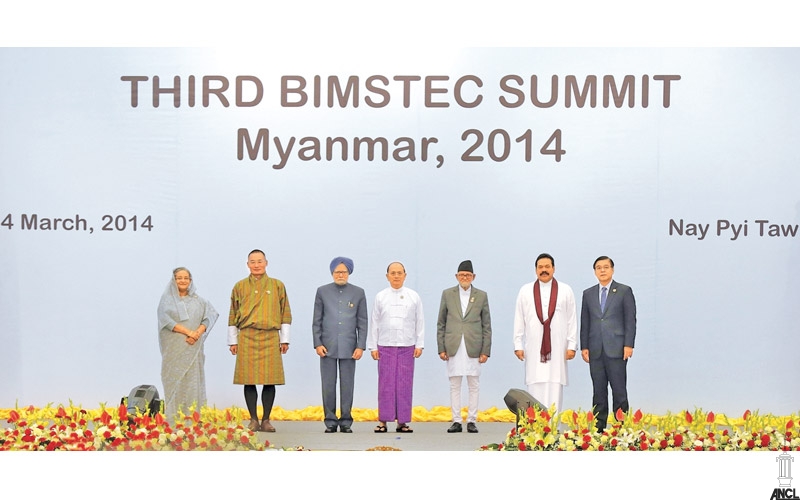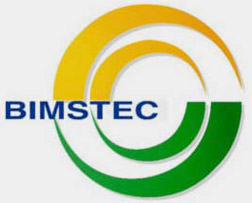


It is encouraging to note that BIMSTEC has broadened its scope to many other areas of collaboration. When the entire world is compelled to deal with terrorism and trans-national crimes, cooperation on this issue has been continuing since 2004. As a country that had suffered from terrorism, for nearly three decades, we in Sri Lanka are acutely aware of its human and economic costs. Unfortunately, Sri Lanka’s economy could not run at its true potential during those years. With the defeat of terrorism, the Sri Lankan economy has been consistently recording, a growth rate of seven per cent.
-President Mahinda Rajapaksa Speech -The Third BIMSTEC Heads of Government Summit-Nay Pyi Taw, Myanmar - March 14, 2014
In the speech at the Third BIMSTEC Heads of Government Summit-Nay Pyi Taw, Myanmar the President further stated that: “I am pleased to acknowledge that BIMSTEC has made significant strides in increasing cooperation among nations in the Bay of Bengal region. The key characteristic of our Organization has been the meeting of the ‘Look West’ policy of the ASEAN nations and the ‘Look East’ policy of their South Asian counterparts, thereby bridging two of the most dynamic regions in the world.”
The Bay of Bengal Initiative for Multi Sectoral Technical and Economic Cooperation (BIMSTEC) is an international organisation established in the latter part of the 1990s as a sub regional group by some South Asian countries and South East Asian countries.

The current members of the BIMSTEC are Bangladesh, Bhutan, India, Myanmar, Nepal, Sri Lanka and Thailand. If one were to trace the history of BIMSTEC, Bangladesh, India Sri Lanka and Thailand initially convened a meeting in Bangkok and jointly formed a new sub-group on June 6, 1997 by the name BIST-EC (Bangladesh, India, Sri Lanka, Thailand – Economic Cooperation). Originally Myanmar attended this summit as an observer and obtained full membership in December, 1997. With this new addition of membership, the name of the organisation was changed to BIMST – EC. Subsequently Nepal and Bhutan also joined in 2004. In the first Summit of Heads of Governments held on July 31, 2004, the leaders of the group decided that the name of grouping should be BIMSTEC or the Bay of Bengal Initiative for Multi-Sectoral Technical and Economic Cooperation. BIMSTEC was established with the objective of synchronising the ‘Look West’ policy of Thailand and ASEAN together with the ‘Look East’ policy of India and South Asia.
The Bangkok Declaration on the establishment of BIMSTEC explicitly spelt out the objectives of the organisation. These objectives were to establish an enabling environment for rapid economic development, accelerate social progress in the sub region, and promote active collaboration and mutual assistance on matters of common interest. BIMSTEC has 14 priority sectors covering all areas of cooperation while Sri Lanka gives leadership to the technology sector.
Economic development activities
The most significant feature in the economic development activities of BIMSTEC is the proposed Free Trade Area amongst the member countries which expected to expand it later to involve other countries as well as other Regional Trading Blocs.
It was the BIMST–EC Economic Ministerial Meeting held in August 1988 which concluded with certain decisions that BIMST–EC should aim to develop a Free Trade Agreement. At the BIMSTEC Trade, Commerce and Economic Ministerial meeting held on February 8, 2004 in Phuket Thailand, the member countries jointly entered in to a Framework Agreement to establish a Free Trade Area by 2013 to create a conducive environment for trade for member countries without any barriers. Initially Bangladesh did not sign the agreement due to prevailing domestic issues, but later Bangladesh joined for the Framework Agreement. The objective of the Agreement is to strengthen and enhance economic, trade and investment cooperation among the members, progressively liberalise and promote trade goods and services and explore new areas. The Trade Negotiating Committee (TNC) was set up in 2004 to continue all negotiations on the implementation of FTA. Trade negotiations mainly cover all trade in goods, outline the reduction and elimination of tariffs with more flexibility granted to the LDCs. The Committee is required to start deliberations on general rules, etc., focusing the preparation of a positive and a negative list. It is expected to expedite implementation of FAT by the regular TNC meetings being held now.
The significance of BIMSTEC to Sri Lanka lies in the fact that it creates an important trade agreement within member countries including Sri Lanka, as it has the potential to be a bridge for long term trade in South Asia and South East Asia. It traverses significant areas of Asia. The BIMSTEC region comprises US$ 2,454 billion GDP containing 1.5 billion population and US$ 1,135 billion total trade. This organisation brings together diverse cultural, social and economic groups. Socially and economically, Sri Lanka, India and Thailand are defined as Non-Less Developed Countries and other four countries Bangladesh, Bhutan, Myanmar and Nepal are in the Less Developed Countries category.
Free Trade Agreements (FTAs)
At the present time Japan has expressed its willingness to assist BIMSTEC to achieve its objectives. BIMSTEC, the organised trade bloc in South Asia and South East Asia, is indeed fortunate to share the cooperation extended by Japan as the fifth economic power in the world. Sri Lanka has been trading with Japan which is our ninth largest export market with US$ 226 million (2013) exports during a long period of time.
The possibility of Japan joining BIMSTEC will make a better platform for Sri Lanka to expand her share in this leading market. It is thought today that China too would consider extending its cooperation to BIMSTEC. Since 2003, China has entered nine Free Trade Agreements (FTAs) and China is still looking forward to have more FTAs with Asia. Presently a few FTAs are in progress of development according to China’s preference such as the China-India Regional Trade Arrangement Study, China-Korea FTA Joint Feasibility Study, and China-Japan-Korea Joint Study. Presently, cooperation amongst trading blocs has increased and important discussions are being held regarding free trade facilities in a global social economic scenario. ASEAN having a FTA with New Zealand and Australia is one such case. Some economists predict that in future the ASEAN will cooperate with BIMSTEC to create a wider free trade area in Asia. Thailand and Myanmar as members of the ASEAN have great potential in making this concept a reality.
Sri Lanka ’s first FTA signed with India in 2000 was the first bilateral FTA of India. Since then, the implementation of the Sri Lanka-Pakistan FTA became effective from 2005. As a member of SAARC, Sri Lanka became a member of the South Asian Free Trade Area (SAFTA), which came into force in 2006. Sri Lanka had discussions and negotiations with Bangladesh and Egypt for FTAs in early 2000 but did not continue discussions. Currently the discussions are in progress to implement a FTA between Sri Lanka and China. However BIMSTEC FTA will be of significance as it is at a reachable threshold.
It may be argued that as Sri Lanka is already in SAFTA and FTA with India, Sri Lanka could utilise benefits of these agreements as most of member countries of BIMSTEC are South Asian nations and they have their own SAFTA agreements. Further, India covers the bulk of trade of Sri Lanka whereas Myanmar and Thailand cover only 3 per cent of Sri Lanka’s total trade. But with the world moving rapidly towards liberalised trade, FTAs hold an integral part of trading pacts. This factor provides opportunities not only for trade without barriers, but also to improve and promote activities like investment and tourism among others.
T.K. Premadasa, former Head of Corporate Affairs and Communications of the Sri Lanka Export Development Board has stated that the Strategic Plan 2010-2015 of the Sri Lanka Export Development Board, the National Plan for Export Development indicate that one of the targets under the plan is to increase exports to markets other than EU and USA by over 50 per cent by 2015.
Myanmar-Sri Lanka Friendship Association
The increase of 50 per cent exports of export markets other than EU and USA is not an easy target. The EDB Strategic Plan also indicates that China, Russia and other Asian countries emerging as friendly nations of Sri Lanka have potential for Sri Lankan exports. If the EDB needs to diversify Sri Lanka’s export destination from Europe to Asia and other countries, they should utilise these opportunities to its best. Although it takes time to implement a FTA, Sri Lanka should be ready to utilise it. Even the promotional strategies should now build up with new tendencies in BIMSTEC countries for long term benefit.
Sri Lanka ’s exports to Myanmar value at US$ one million, ranking at the 116th position in the list of export destinations. This reveals that very negligible trade is done with Myanmar. The main reason is that Sri Lanka maintains only political and cultural relationships as a Buddhist country, not focusing much on trade. At the present time, Myanmar is displaying its willingness to politically change its governing system and is moving towards a more liberal path. The Sri Lankan government together with the chambers should develop a new mechanism on how to enter the Myanmar market strategically. It is a timely need to organise trade missions to Myanmar and strengthen relations with its respective counterparts in Myanmar such as the Myanmar-Sri Lanka Friendship Association. As far as Thailand is concerned, its trade relations needs to be examined from a wider perspective. Even though Thailand ranks 34th in Sri Lanka’s export destination list with exports of US$ 56 million, Sri Lanka exports nearly 25 major export products.
Thailand is the second largest Sri Lanka export market for gems and diamond next to USA. Thailand is not only the important market for gems, jewellery and diamonds, but also maintains most important market status for Sri Lanka in South East Asia after Singapore. On the other hand, Sri Lanka imports nearly US$ 430 million worth of products from Thailand, ranking as the 10th largest importer. This shows a huge unfavourable trade balance for Sri Lanka between the two countries. With the implementation of BIMSTEC, the advantages of FTA may be favourable to Thailand, but the authorities in export development should look into the scenario seriously and take necessary steps to narrow the gap as a remedial measure. The Sri Lanka-China FTA is a much discussed topic in the business community In the light of available evidence, the BIMSTEC Free Trade Agreement is likely to take effect before the FTA with China as it is already notified in the list of the World Trade Organization among other reasons.
Regional cooperation
It must be noted that the achievements of BIMSTEC through regional cooperation in the political, economic and cultural spheres since its inception in 1997 are commendable, which provide encouragement to seek new avenues of cooperation.
Although BIMSTEC nations have collaborated in many sectors as a founder member, Sri Lanka is committed to the BIMSTEC process. Sri Lanka as an active participant is the Lead Country in the Technology Sector and the Permanent Chair of the Trade Negotiating Committee, for a Free Trade Agreement. This Agreement, once finalized, will open new vistas to increase trade and economic cooperation in the region.
The development of regional cooperation among the countries has given an impetus to create a free trading environment. The main objective of the bilateral or regional Free Trade Agreement is to build up a treaty between two or more countries that do not impose tariffs for trade conduct across their borders. Ultimately it will provide a conducive environment among member nations for business to compete globally. Sri Lanka has to deal with a massive sub-region. It is therefore imperative for all the parties and public and private sectors involved to join hands to achieve the best out of an FTA of BIMSTEC with maximum benefit to Sri Lanka.
The theme for the third BIMSTEC Summit: "Partnership for Harmony and Prosperity," spells out the significance of BIMSTEC for Sri Lanka and its other member nations in that the Sri Lankan economy has been consistently recording, a growth rate of seven per cent at the present time and would immensely benefit from building treaties to develop trade between Sri Lanka and other member countries of BIMSTEC thereby ensuring the future economic prosperity of our motherland.
From: Daily News. http://www.dailynews.lk/?q=features/bimstec-and-its-broad-brush-gains-sri-lanka




